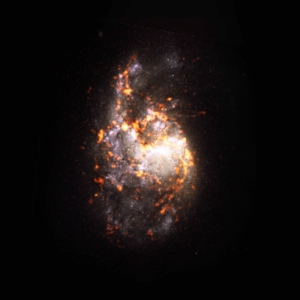Using gas velocity data, scientists observing Elias 2-27 were able to directly measure the mass of the young star’s protoplanetary disk and also trace dynamical perturbations in the star system. Visible in this animation are the dust continuum 0.87mm emission data (blue), along with emissions from gases C18O (yellow) and 13CO (red).


PHANGS-ALMA Survey: NGC4254
Shown here as an ALMA (orange) composite with Hubble Space Telescope (red) data, NGC4254 was among the nearly 100 galaxies included in the recent PHANGS project census of galaxies in the nearby Universe. The survey found that stellar nurseries within these galaxies vary widely in appearance and behavior, and that these characteristics heavily depend on where the stellar nurseries are located. NGC4254 is an example of a galaxy featuring M type morphology.

PHANGS-ALMA Survey: NGC1566
Seen here as an ALMA (orange) composite with Hubble Space Telescope (red) data, NGC1566 was among the nearly 100 galaxies catalogued by the PHANGS survey of the nearby Universe. NGC1566 exhibits grand-design spiral plus stellar bar morphology.

PHANGS-ALMA Survey: NGC0628
While conducting a census of nearly 100 galaxies in the nearby Universe, the PHANGS survey observed NGC0628, a galaxy with pure grand-design spiral morphology. NGC0628 is shown here as an ALMA (orange) composite with Hubble Space Telescope (red) data.

PHANGS-ALMA Survey: NGC1385
During a survey of nearly 100 galaxies in the nearby Universe, the PHANGS team observed NGC1385, a galaxy featuring pure flocculent disk morphology. The survey concluded that contrary to accepted scientific theory, not all stellar nurseries look or act the same. NG1385 is shown here as an ALMA (orange) composite with Hubble Space Telescope (red) data.

PHANGS-ALMA Survey: NGC4535
NGC4535 is a galaxy in the nearby Universe featuring grand-design spiral plus stellar bar morphology. It was catalogued along with nearly 100 other galaxies during a recent census by the PHANGS project. The census revealed that contrary to commonly accepted scientific theory, not all stellar nurseries look or act the same way. In fact, they’re quite diverse. NGC4535 is shown here as an ALMA (orange) composite with Hubble Space Telescope (red) data.





